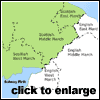
|
The Border Reivers Printed with permission of the Official Border Reivers Website
As George MacDonald Fraser explains in his book, The Steel Bonnets,: "The great border tribes of both Scotland and England feuded continuously among themselves. Robbery and blackmail were everyday professions; raiding, arson, kidnapping, murder, and extortion were an accepted part of the social system.
The Border Lands, territorial patch of the Border Reiver, straddle the once disputed boundary and Debatable Land between "two of the most energetic, aggressive, talented and all together formidable nations in history", England and Scotland. They stretch in one broad sweep from the Solway Firth in the west to the Northumbrian and Berwickshire coast in the east and comprise the Cheviot Hills and parts of the Southern Uplands and the Pennines. To the west, they are the Solway Coast and the Eden Valley, to the east, the Merse. They are riven by the waters of the Nith, the Annan, the Esk, the Teviot, the Tweed, and by Redesdale, Coquetdale, Tynedale and, of course Liddesdale, scene of so many of the bloodiest events of the Reiving years.
The area is liberally dotted with castles, stately homes, the ruins of historic abbeys, fortified farmhouses (bastles), the scattered remains of pele towers and the atmospheric remnants of abandoned hamlets or howfs, hidden up remote side valleys. The many towns and settlements that were raided, the fortified churches and the defensive walls and dykes dating back to Elizabeth I and her forbears, the fields of battle and the Reiver graveyards all bear testament to the turbulent history that marked these lands and those times. The brutal activities of the warring families and the indiscriminate plundering and merciless cruelty that drove fear deep into the very souls of ordinary Border folk. Other vestiges of that virtually ungovernable region, of that lawless state that was allowed to flourish, more or less unchecked, for the best part of 350 years, reside within the ancient seats of power, the Warden families such as the Buccleuchs, Dacres, Humes and Scropes, the frontier garrisons, the places of truce. And on the Reiver side, there are the secret places of sanctuary, the lairs they fled to in the heat of pursuit, the 'hot trod'; mosses and wastes where pursuing posses could find themselves at a distinct disadvantage; hidden valleys where one thousand head of cattle could be spirited away. This article was printed with the permission of the Official Border Reiver's Website at http://www.reivers.com To read more about the Official Border Reivers Website and its educational programs, contact them by E-Mail at: admin@reivers.com Links: An Introduction to the Border Reivers by Stuart Bird |
Thursday, December 26th, 2019
Attention visitors: Tartans.com is back. Please note that this is a snapshot of the site as it existed nearly 20 years ago and you may encounter broken links; we are still combing through the site and correcting those as we find them. Please also note that some sections are currently not functional, primarily the discussion forums/clan chat boards.
|
** HOME - First Time Visitors - Glossary - - Contact Us ** Awards | Bibliography | Clan Calendar | Clan Chat | Clan Finder | History | Famous Scots | Genealogy | Great Hall of the Clans | Links | News and Features | Scots on the Net | Search | Site Map The Gathering of the Clans
Copyright 1995- Tartans.com - All Rights Reserved. |


